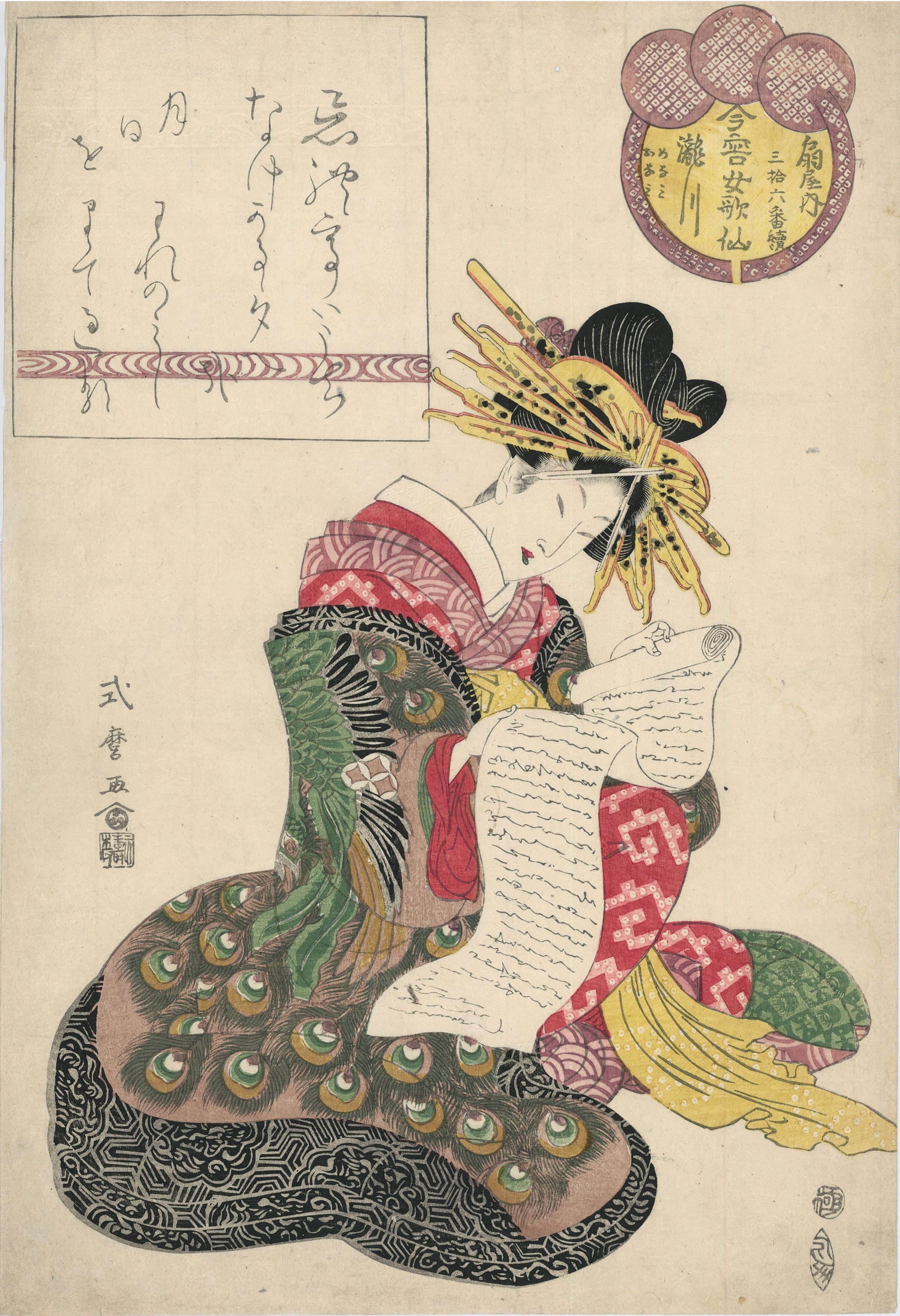 Image 1 of 2
Image 1 of 2

 Image 2 of 2
Image 2 of 2



Shikimaro | Takigawa of the Ogiya, kamuro Menami and Onami, Female Poetic Immortals in the Modern Style, a Set of Thirty-six
喜多川式麿 Kitagawa Shikimaro (dates unknown)
扇屋内 三十六番続き 今様女歌仙 瀬川
Takigawa of the Ogiya, kamuro Menami and Onami, from the series Female Poetic Immortals in the Modern Style, a Set of Thirty-six
1813
木版画 | 纵绘大判 | 38cm x 26cm
Woodblock-print | Oban tate -e | 38cm x 26cm
早期版次;颜色保存非常好;整体品相非常好
Fine impression, color and good condition
$3,800
喜多川式麿,江户时期一位神秘的浮世绘画师,其生平暂不可考,生卒年亦不详,只知其师从喜多川歌麿弟子喜多川月麿,从某种意义上可理解为歌麿的徒孙。
三十六歌仙,多指代三十六位平安时期的和歌名人,最早出典自平安时期中期公卿、歌人藤原公任(966-1041)所编撰的《三十六人撰》。千年以来,三十六歌仙已在日本文学乃至文艺史上占据了重要地位,后世的无数艺术家都以此为母题创作过许多优秀作品,直至今日依然热度不减。
作为美人画中的常客,扇屋家的泷川姑娘以其多变的造型折服了无数观者。在式麿的笔下,她的气质是温柔娴静的:手捧长卷细细研读,眉梢眼角都泛着笑意,微张的樱桃小口,似乎在低声吟诵着诗句,一袭锦地孔雀图华服自然垂地,其上泛着金属绿色的眼斑羽纹与发间金黄的玳瑁簪钗交相辉映,衬托出“女歌仙”泷川的派头十足。如此秀外慧中的美人,谁能不爱?
The Thirty-Six Immortal Female Poets were a group of novelists and poets who flourished in the Imperial Court in Kyoto from the 9th to 13th Centuries in the Heian Period. With little else to do, really, women in the court excelled at various artistic endeavors, and many scholars believe this ancient period marked a zenith of Japanese poetry. They would join genial competitions and read their work, which would be celebrated throughout the subsequent centuries.
In this fine print by Kitagawa Shikimaro, about whom not a great deal is known, we see one of the poets reading her work from a scroll. The fact that many of the poets’ actual names were lost to history, scholars have said, is an indication of their marginalization in the Imperial Court (and in Japanese society in general) at the time.
The poet is wearing modern dress that would have felt current in Shikimaro’s time (around 1813). This is a device we’ll see again and again in Ukiyoe – taking something from Japan’s storied past and dressing it up for a modern audience. Her strikingly colored, multi-layered outfit, including an elaborate plumage design, is magnificent to behold.
Interested in purchasing?
Please contact us.
喜多川式麿 Kitagawa Shikimaro (dates unknown)
扇屋内 三十六番続き 今様女歌仙 瀬川
Takigawa of the Ogiya, kamuro Menami and Onami, from the series Female Poetic Immortals in the Modern Style, a Set of Thirty-six
1813
木版画 | 纵绘大判 | 38cm x 26cm
Woodblock-print | Oban tate -e | 38cm x 26cm
早期版次;颜色保存非常好;整体品相非常好
Fine impression, color and good condition
$3,800
喜多川式麿,江户时期一位神秘的浮世绘画师,其生平暂不可考,生卒年亦不详,只知其师从喜多川歌麿弟子喜多川月麿,从某种意义上可理解为歌麿的徒孙。
三十六歌仙,多指代三十六位平安时期的和歌名人,最早出典自平安时期中期公卿、歌人藤原公任(966-1041)所编撰的《三十六人撰》。千年以来,三十六歌仙已在日本文学乃至文艺史上占据了重要地位,后世的无数艺术家都以此为母题创作过许多优秀作品,直至今日依然热度不减。
作为美人画中的常客,扇屋家的泷川姑娘以其多变的造型折服了无数观者。在式麿的笔下,她的气质是温柔娴静的:手捧长卷细细研读,眉梢眼角都泛着笑意,微张的樱桃小口,似乎在低声吟诵着诗句,一袭锦地孔雀图华服自然垂地,其上泛着金属绿色的眼斑羽纹与发间金黄的玳瑁簪钗交相辉映,衬托出“女歌仙”泷川的派头十足。如此秀外慧中的美人,谁能不爱?
The Thirty-Six Immortal Female Poets were a group of novelists and poets who flourished in the Imperial Court in Kyoto from the 9th to 13th Centuries in the Heian Period. With little else to do, really, women in the court excelled at various artistic endeavors, and many scholars believe this ancient period marked a zenith of Japanese poetry. They would join genial competitions and read their work, which would be celebrated throughout the subsequent centuries.
In this fine print by Kitagawa Shikimaro, about whom not a great deal is known, we see one of the poets reading her work from a scroll. The fact that many of the poets’ actual names were lost to history, scholars have said, is an indication of their marginalization in the Imperial Court (and in Japanese society in general) at the time.
The poet is wearing modern dress that would have felt current in Shikimaro’s time (around 1813). This is a device we’ll see again and again in Ukiyoe – taking something from Japan’s storied past and dressing it up for a modern audience. Her strikingly colored, multi-layered outfit, including an elaborate plumage design, is magnificent to behold.
Interested in purchasing?
Please contact us.
喜多川式麿 Kitagawa Shikimaro (dates unknown)
扇屋内 三十六番続き 今様女歌仙 瀬川
Takigawa of the Ogiya, kamuro Menami and Onami, from the series Female Poetic Immortals in the Modern Style, a Set of Thirty-six
1813
木版画 | 纵绘大判 | 38cm x 26cm
Woodblock-print | Oban tate -e | 38cm x 26cm
早期版次;颜色保存非常好;整体品相非常好
Fine impression, color and good condition
$3,800
喜多川式麿,江户时期一位神秘的浮世绘画师,其生平暂不可考,生卒年亦不详,只知其师从喜多川歌麿弟子喜多川月麿,从某种意义上可理解为歌麿的徒孙。
三十六歌仙,多指代三十六位平安时期的和歌名人,最早出典自平安时期中期公卿、歌人藤原公任(966-1041)所编撰的《三十六人撰》。千年以来,三十六歌仙已在日本文学乃至文艺史上占据了重要地位,后世的无数艺术家都以此为母题创作过许多优秀作品,直至今日依然热度不减。
作为美人画中的常客,扇屋家的泷川姑娘以其多变的造型折服了无数观者。在式麿的笔下,她的气质是温柔娴静的:手捧长卷细细研读,眉梢眼角都泛着笑意,微张的樱桃小口,似乎在低声吟诵着诗句,一袭锦地孔雀图华服自然垂地,其上泛着金属绿色的眼斑羽纹与发间金黄的玳瑁簪钗交相辉映,衬托出“女歌仙”泷川的派头十足。如此秀外慧中的美人,谁能不爱?
The Thirty-Six Immortal Female Poets were a group of novelists and poets who flourished in the Imperial Court in Kyoto from the 9th to 13th Centuries in the Heian Period. With little else to do, really, women in the court excelled at various artistic endeavors, and many scholars believe this ancient period marked a zenith of Japanese poetry. They would join genial competitions and read their work, which would be celebrated throughout the subsequent centuries.
In this fine print by Kitagawa Shikimaro, about whom not a great deal is known, we see one of the poets reading her work from a scroll. The fact that many of the poets’ actual names were lost to history, scholars have said, is an indication of their marginalization in the Imperial Court (and in Japanese society in general) at the time.
The poet is wearing modern dress that would have felt current in Shikimaro’s time (around 1813). This is a device we’ll see again and again in Ukiyoe – taking something from Japan’s storied past and dressing it up for a modern audience. Her strikingly colored, multi-layered outfit, including an elaborate plumage design, is magnificent to behold.
Interested in purchasing?
Please contact us.
